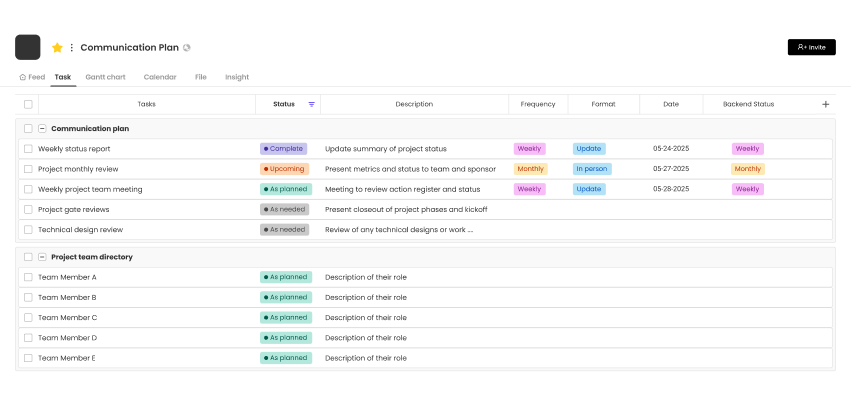Have you ever witnessed a promising project fail due to poor communication? Teams can become overwhelmed by a flood of emails, causing crucial updates to be overlooked. Stakeholders may make decisions based on outdated information, leading to rising frustrations. This chaos often stems from the absence of a communication management plan. The success of a project hinges on one fundamental truth: effective communication is essential for great outcomes.
This is where team communication tools come into play. A well-structured plan ensures that the right people receive the right information at the right time. Whether your team is small or your project is complex, mastering communication can transform your workflow. Are you ready to turn communication from a challenge into a strength? Let’s get started.
What Is a Communication Management Plan?
A communication management plan outlines how information is shared in a project, ensuring the right people receive timely messages. It details who needs what information, when, and how it will be delivered, using various methods like emails and meetings to minimize misunderstandings and keep teams aligned.
Program vs. Project-Level Communication
A program communication plan addresses multiple related projects, while a project-level communication plan focuses on a single project. Program communication is broader, ensuring that all projects align with organizational goals. In contrast, project communication is more detailed, concentrating on daily updates and task assignments. Both are vital for seamless operations.
Why Is a Communication Plan Important?
A robust communication management plan is crucial for preventing confusion and keeping projects on track. Without it, teams may struggle with excessive messages, unclear expectations, and missed deadlines. Here’s why a communication plan is essential.
Aligning Stakeholders
Stakeholders, including team members, managers, clients, and vendors, have varying information needs. A communication management plan ensures that everyone receives updates relevant to their roles. This alignment helps prevent conflicts and keeps the project progressing smoothly.
Reducing Communication Overload
An influx of emails, messages, and meetings can overwhelm teams. A well-crafted plan filters out unnecessary noise, identifying which updates are essential and which can wait. This approach allows team members to focus on their work rather than being inundated with messages.
Increasing Project Visibility
Structured communication enables leaders to track progress easily. Dashboards, reports, and scheduled updates provide clarity on what is working and what isn’t. This visibility allows teams to address issues before they escalate.
Key Components of a Communication Plan
Every successful project relies on clear communication. A strong communication management plan serves as a roadmap for sharing information, ensuring that everyone receives what they need when they need it. Without this structure, teams may waste time chasing updates or overlook important details. Let’s explore the essential elements that make a communication plan effective.
Stakeholder Directory
Identifying who needs information is the first step. A stakeholder directory acts as your project’s contact list, including everyone involved, from team members to clients. This list should detail names, job roles, and their connection to the project.
However, it goes beyond just names. A good directory notes each person’s preferred method of receiving updates. Some may prefer detailed emails, while others might opt for quick chats. Some need daily updates, while others only want major news. Keeping this list current is crucial as team members join or leave the project.
Communication Objectives
A plan without clear goals is like navigating without a map. Communication objectives clarify how you will share information and what you aim to achieve. These goals guide every message you send.
Common objectives include keeping everyone informed about progress, obtaining quick approvals, or resolving issues swiftly. Some plans aim to reduce unnecessary emails by organizing updates more effectively. Your objectives should align with your project’s needs.
Write down two or three main goals. Make them measurable and straightforward. For example, “Reduce meeting time by implementing weekly email updates.” Clear goals help determine what to communicate and how often.
Methods and Channels
Not all messages should use the same tool. Selecting the right channel for each type of update saves time and reduces confusion. The method should match the message’s importance and urgency.
Quick questions are best suited for team chat apps, while significant changes may require a video call or meeting. Formal updates often go via email, and project dashboards help teams track progress without additional meetings.
Consider your team’s work style as well. Remote teams may need more video calls, while fast-paced projects could benefit from instant messaging for quick decisions. Choose tools that everyone can use easily; too many tools can create more problems than they solve.
Cadence and Frequency
Some updates should occur regularly, while others are needed only when changes arise. Your plan should establish clear expectations for how often information is shared.
Daily updates might consist of brief check-ins about tasks, while weekly reports could summarize progress for managers. Monthly meetings may review the overall project status. Additionally, plan for unexpected updates when issues arise.
Set guidelines for urgent messages as well. Determine who needs to be informed about delays immediately and how to communicate budget changes or new deadlines. Having these rules in place facilitates quick action when necessary.
Message Ownership and Responsibilities
When everyone can send updates, it can become unclear who to trust. Your plan should specify who is responsible for sharing which information. This clarity prevents duplicate messages or missed updates.
Project managers typically handle significant updates for leaders and clients, while team leads may update their groups on daily tasks. Technical experts can explain complex changes. Ensure everyone understands their communication responsibilities.
Also, establish who approves messages before they are sent out. Some updates may require a manager’s approval, while others can go directly to the team. Clear guidelines maintain accuracy and consistency in communication.
Format and Documentation
Consistency makes communication easier to follow. Set standard formats for common updates, such as reports or meeting notes, to help people find what they need quickly.
Create simple templates for emails and documents, using the same headings and sections each time. This approach saves time and enhances professionalism.
Decide where to store all project communications. A shared folder or project management tool is ideal. Everyone should know where to find past updates and documents, preventing the need to sift through old emails when questions arise.
Making It All Work Together
These components create a comprehensive communication system. Start with your stakeholder list and objectives, then choose methods that meet those needs. Establish a schedule that keeps everyone informed without overwhelming them.
Assign clear roles so everyone knows their responsibilities. Use consistent formats to save time and reduce confusion. Store all information in an easily accessible location.
Effective communication plans evolve with the project. Regularly check in to see what’s working and ask the team if they’re receiving the information they need. Adjust the plan as the project progresses.
The best plans are straightforward yet thorough. They help teams concentrate on their work instead of chasing down information. With these key components in place, your project communication will flow smoothly from start to finish.
How to Create a Communication Management Plan
Effective communication is essential for keeping projects on track. A communication management plan ensures that everyone receives the right information at the right time. Without this plan, teams may waste time on irrelevant updates or overlook critical details. This guide will help you develop a robust communication plan.
Step 1 – Identify Stakeholders
Before creating your plan, identify who needs information. Stakeholders are individuals invested in the project, including team members, managers, clients, and suppliers.
Begin by listing all stakeholders. Include their names, roles, and their connection to the project. Consider what information each person requires. Some may need daily updates, while others may only want major announcements. Be sure to include anyone who could be impacted by the project.
Once you have your list, prioritize stakeholders based on their importance. Key decision-makers should receive more attention. Also, note their preferred communication methods—some may prefer emails, while others might favor quick chats. Understanding these preferences will enhance your plan.
Step 2 – Set Clear Communication Goals
Every effective plan requires clear goals. These goals define the purpose of your communication and what you aim to achieve. Without specific goals, messages can become random and ineffective.
Consider the most pressing needs of your project. You might want to dispel rumors by sharing accurate information promptly or expedite approvals from management. Your goals could include reducing unnecessary emails or ensuring everyone is informed of project changes immediately.
Document two or three primary communication goals. Keep them straightforward and measurable. For example, “Reduce email inquiries by 50% using a project dashboard.” Clear goals will guide your messaging and approach.
Step 3 – Choose Communication Methods and Tools
Next, determine how you will share information. Different types of messages require different tools. A quick question may be best suited for a chat app, while significant changes might warrant a meeting.
Consider your team’s needs. If team members work remotely, video calls can facilitate connection. Messaging apps are ideal for quick updates, while important documents should be shared via email or stored in an accessible location.
Project management tools like Morningmate or Trello can provide visibility into progress without the need for frequent meetings. Dashboards allow team members to check their status at any time. Choose tools that align with your team’s workflow, and avoid overwhelming them with too many options.
Step 4 – Define Frequency and Triggers
Some messages should be sent regularly, while others are only necessary when specific events occur. Your plan should outline the timing for each type of update.
Daily updates might consist of brief check-ins on tasks, while weekly reports could summarize progress for management. Monthly meetings may focus on overarching goals. Additionally, plan for unexpected updates, such as issues or changes.
Establish guidelines for urgent messages. For instance, who should be notified immediately if costs exceed the budget? If a deadline is at risk, how will you inform the team? Having these protocols in place saves time during critical moments.
Step 5 – Assign Roles and Responsibilities
A communication plan is only effective if everyone adheres to it. Assign specific individuals to send each type of message. Without clear roles, updates may be overlooked, or multiple people may send the same information.
Typically, the project manager handles major updates for stakeholders and clients, while team leaders may update their respective groups. Technical experts can clarify complex changes. Ensure everyone understands their communication responsibilities.
Also, determine who can approve messages before they are sent. Some updates may require managerial approval, while others can go directly to the team. Clear guidelines help prevent misinformation from spreading.
Step 6 – Share and Maintain the Plan
Your plan is ineffective if no one uses it. Share it with all involved parties and explain its purpose. Store it in an easily accessible location, such as a shared folder or project management tool.
Regularly review the plan to ensure its effectiveness. Solicit feedback from your team about the timing of updates. If team members feel overwhelmed by messages, adjust the plan accordingly. If additional information is needed, incorporate it.
Update the plan as the project evolves. New team members may require different updates, and significant project changes may necessitate new communication methods.
Tips for Managing Communication Throughout a Project
A communication management plan is only effective when implemented correctly. These tips can help teams stay aligned and avoid common pitfalls.
Centralize Updates with Project Management Software (e.g., Morningmate)

Project management tools like Morningmate consolidate all updates in one location. Teams can track progress, share files, and communicate without switching between applications. Centralized tools minimize confusion and save time.
Balance Synchronous and Asynchronous Communication
Synchronous communication occurs in real-time, such as during meetings or calls, while asynchronous communication includes emails or messages that do not require an immediate response. A well-rounded plan balances both types to keep teams connected without constant interruptions.
Review and Update the Plan Regularly
Projects evolve, and so should your communication plan. Regular check-ins ensure the plan remains effective. If stakeholders require more or fewer updates, adjust the plan to meet their needs.
Final Thoughts on Communication Plans
A well-crafted communication management plan is more than just a document; it is a vital tool for ensuring project success. Teams that communicate effectively complete projects more efficiently and with fewer issues.
Make Communication a Strategic Advantage
Strong communication distinguishes successful teams. A clear plan ensures everyone understands what is happening and what actions to take next. By prioritizing communication, teams can gain a competitive edge.
As projects become increasingly complex in 2025, a solid communication management plan will be essential for success. Follow these steps, utilize the right tools, and continuously refine your plan. The outcome will be a cohesive team that collaborates seamlessly and delivers outstanding results.




